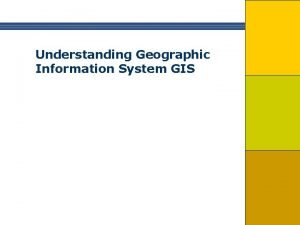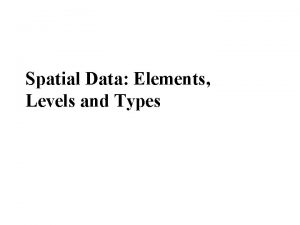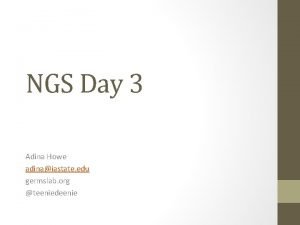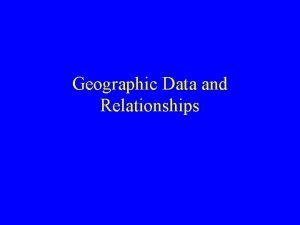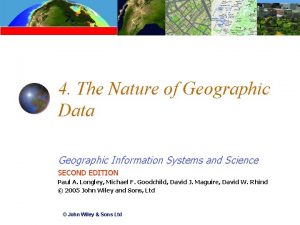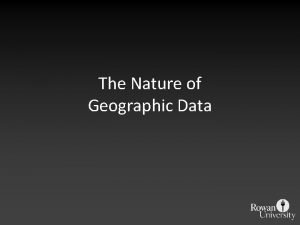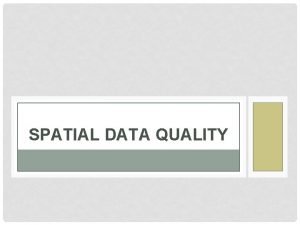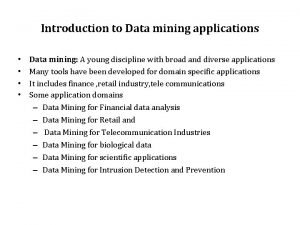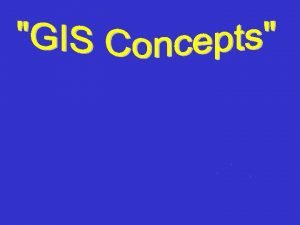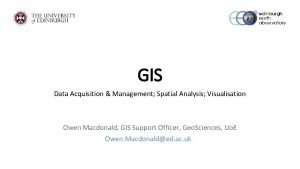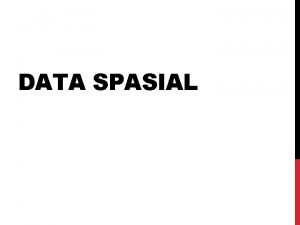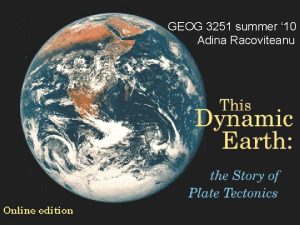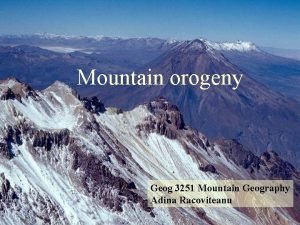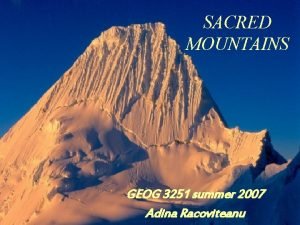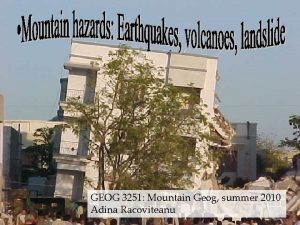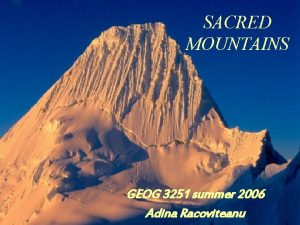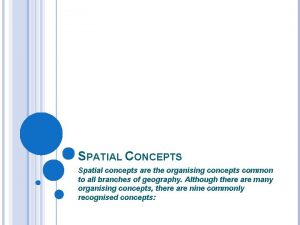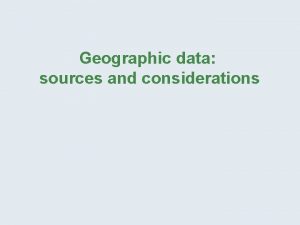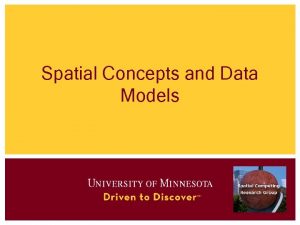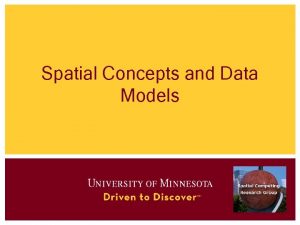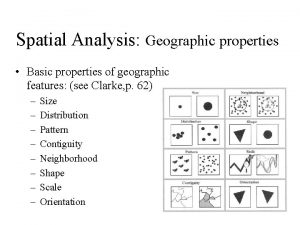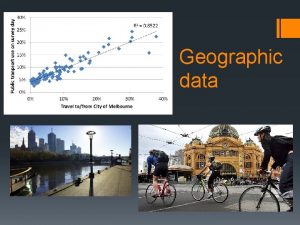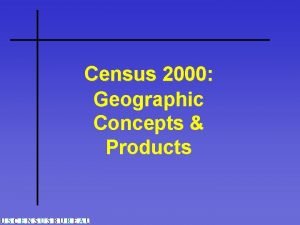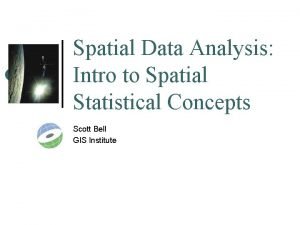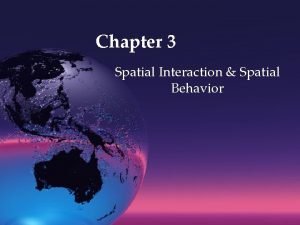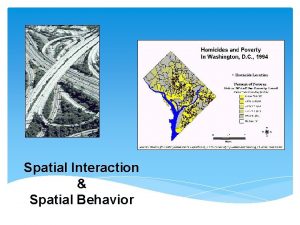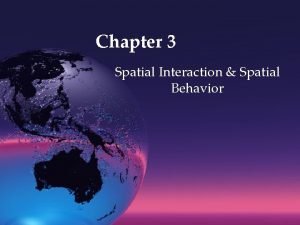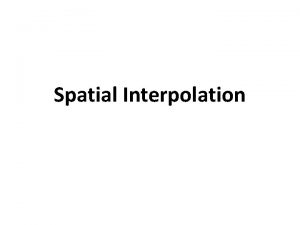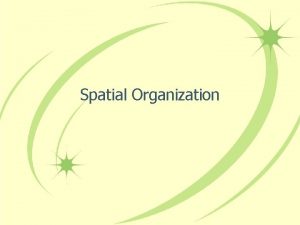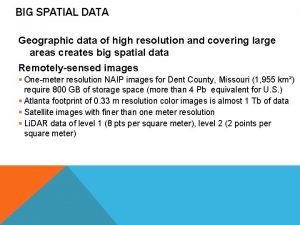Geographic concepts and spatial data Adina Racoviteanu Lecture






















- Slides: 22

Geographic concepts and spatial data Adina Racoviteanu Lecture # 2, GEOG 4103 spring 2006

Outline • • • Spatial Cognition Types of objects Scale Spatial measurement levels Spatial patterns

Human perception of the world • world consists of objects, events, processes, and a background environment • cognition = acquisition, storage and retrieval, manipulation, and use by living creatures • Similar process in GIS

Spatial cognition • cognition of spatial properties of the world: – location – size – distance – direction – shape, pattern, movement, and inter-object relations.

Cognitive Maps • “ Mental maps” • internal representations of the world and its spatial properties stored in memory • can sometimes be distorted (eg. size, shape)

Geospatial data • Two main components: – Spatial component: Where is it? – Non-spatial (thematic) component: What is it?

Spatial data Location = spatial mode of information 1) Absolute location: e. g. geographic position: (x, y) latitude, longitude 2) Relative location

Attribute data • Non-spatial • Attributes =characteristics of objects A table showing the attributes of objects is called an attribute table Name Area Object_1 100 Object_2 200 Elevation 5077 5999 Columns = attributes Rows = objects

What types of geographic objects? • Point data Zero-dimensional (x, y) • Line data One-dimensional (x, y, length) • Area data Two-dimensional (x, y, length, width) • Continuous data Three-dimensional (x, y, length, width, height) volumetric

Scale • Large-scale vs. small-scale • Objects depicted are large • Covers small areas • More detailed • E. g trekking maps, campus map • Objects depicted are small • Covers large areas • Less detailed • Eg. World map

Scale

Generalization

Data measurement levels • Nominal: “named” data – e. g. phone numbers, codes etc… • Ordinal: ranking – measurements differ by order, e. g, 1 st, 2 nd, 3 rd. . – Data can be compared, but only qualitatively • Interval: – Used to quantify differences between measurements, eg. Temperature, distance etc… – Zero point (point of begninning) is arbitrary • Ratio: – Used to quantify ratios, and to compare one measurement to another – Zero point is absolute

Example: • Distance 30 miles origin A B

Geographic Inquiry • • • location and extent; distribution and pattern or shape; spatial association; spatial interaction; Spatial/temporal change

Spatial patterns Regular Random e. g. tree distribution Clustered

Why do data display this spatial pattern (distribution)? • Associations – E. g. apple trees grow in moister environments • Spatial correlations – E. g. there is a relationship between density of trees and terrain slope

Data collection process • Type of data collected depends on the scale we want to look at; • What area needs to be covered? • What is the amount of detail needed? – Small scale: remote sensing imagery – Larger scale: aerial photography – Large scale: field sampling, e. g. GPS

Cartographic maps • Representations of the world • communicate geographical information • Distortions: – projections – scales – perspectives etc. .

Maps as Models Maps are models of reality. They emphasize some aspects of reality in a cartographic representation while ignoring or greatly simplifying other aspects of reality.

Scale the amount of reduction in the representation of a real world geographic phenomenon on a map. or, the ratio of map distance to earth distance 1: 24, 000 verbal scale 1 inch = 2000 ft representative fraction bar scale 1 2000 ft

More on maps next time…
 Spatial data vs non spatial data
Spatial data vs non spatial data Components of gis
Components of gis Spatial data and attribute data
Spatial data and attribute data 01:640:244 lecture notes - lecture 15: plat, idah, farad
01:640:244 lecture notes - lecture 15: plat, idah, farad Research onion
Research onion Kinetoprofilaxia
Kinetoprofilaxia Adina magda florea
Adina magda florea Adina magda florea
Adina magda florea Adina glava
Adina glava Adina howe
Adina howe Adina magda florea
Adina magda florea Adina crainiceanu
Adina crainiceanu Types of geographic data
Types of geographic data Nature of geographic data
Nature of geographic data Coastline paradox
Coastline paradox Dfd symbols are referenced by using all
Dfd symbols are referenced by using all Describe data and process modeling concepts and tools
Describe data and process modeling concepts and tools Quality cont
Quality cont Spatial data mining applications
Spatial data mining applications Spatial data acquisition
Spatial data acquisition Component of gis
Component of gis Gis
Gis Big spatial data
Big spatial data

